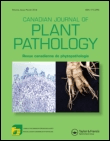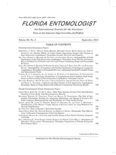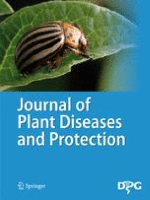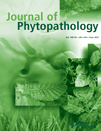
CANADIAN JOURNAL OF PLANT PATHOLOGY
Scope & Guideline
Cultivating knowledge at the intersection of plant science and environmental health.
Introduction
Aims and Scopes
- Pathogen Identification and Characterization:
The journal prioritizes research that identifies and characterizes plant pathogens, including fungi, bacteria, viruses, and nematodes, providing crucial information for disease diagnosis and management. - Disease Management Strategies:
Research articles often explore integrated pest management (IPM) strategies, including biological control, chemical control, and agronomic practices aimed at reducing disease impact on crops. - Plant Resistance Mechanisms:
There is a strong focus on understanding plant resistance mechanisms to various pathogens, including genetic studies and breeding for disease resistance. - Epidemiology and Disease Dynamics:
The journal frequently publishes studies on the epidemiology of plant diseases, including the dynamics of disease spread, environmental influences, and host-pathogen interactions. - Molecular and Genomic Approaches:
Research utilizing molecular and genomic techniques to understand pathogen biology and plant responses to infections is a core area, reflecting the modern trends in plant pathology.
Trending and Emerging
- Molecular Diagnostics and Genomics:
There is an increasing emphasis on molecular diagnostics and genomic approaches to identify and characterize plant pathogens, which enhances the understanding of disease mechanisms and resistance. - Sustainable Disease Management Practices:
Research focusing on sustainable practices, including the use of biological control agents and integrated pest management strategies, is on the rise, reflecting a global shift towards environmentally friendly agricultural practices. - Impact of Climate Change on Plant Pathology:
Emerging studies are examining the effects of climate change on plant disease dynamics, pathogen virulence, and host susceptibility, highlighting the need for adaptive management strategies in agriculture. - Microbiome Research:
The role of plant-associated microbiomes in disease resistance and plant health is gaining attention, with studies exploring how these microbial communities can be harnessed for biocontrol purposes. - Artificial Intelligence in Plant Pathology:
The integration of artificial intelligence and machine learning techniques to analyze disease outbreaks and predict pathogen behavior is emerging as a significant trend, showcasing the intersection of technology and plant pathology.
Declining or Waning
- Traditional Chemical Control Methods:
There has been a noticeable decrease in the focus on traditional chemical control methods for managing plant diseases, as the field shifts towards more sustainable and integrated approaches. - General Surveys without Molecular Insights:
Papers that conduct general surveys of plant diseases without incorporating molecular insights or advanced diagnostic methods are appearing less frequently, indicating a shift towards more rigorous methodologies. - Regional Focus on Specific Pathogens:
Research that focuses exclusively on region-specific pathogens without broader implications or applications has declined, as the journal seeks to address more globally relevant issues in plant pathology.
Similar Journals

MOLECULAR PLANT PATHOLOGY
Pioneering research for a healthier planet.MOLECULAR PLANT PATHOLOGY, published by Wiley, is a leading academic journal in the fields of Agronomy, Molecular Biology, Plant Science, and Soil Science, with a strong reputation underscored by its impressive Q1 rankings across multiple categories and a Scopus rank placing it in the top echelons of its fields. Since embracing Open Access in 2019, this journal has significantly broadened its reach, enhancing visibility and accessibility for researchers, professionals, and students alike. With a commitment to publishing high-quality, innovative research, MOLECULAR PLANT PATHOLOGY serves as a critical platform for advancing our understanding of plant diseases and pathogenesis, contributing to the development of sustainable agricultural practices. As a vital resource for scholarly communication, it fosters collaboration among scientists and supports the sharing of vital knowledge that addresses issues of global food security and environmental health.

JOURNAL OF PLANT PATHOLOGY
Transforming Knowledge into Solutions for AgricultureJOURNAL OF PLANT PATHOLOGY, published by SPRINGER, is a premier academic journal dedicated to advancing the understanding of phytopathology and related fields. With a strong international presence and an impact factor that reflects its influence in the scientific community, this journal offers essential insights to researchers, professionals, and students engaged in plant health. Since its inception in 1997, it has consistently provided a platform for innovative research, contributing to the Q2 rank in Plant Science as per the 2023 category quartiles. The journal covers a broad spectrum of topics related to plant diseases, their management, and the ecological impacts they pose, ensuring relevance to contemporary challenges in agriculture and sustainability. While the journal does not currently offer Open Access options, it remains a crucial resource for those looking to deepen their knowledge and bolster their research endeavors in the vital area of plant pathology.

PHYTOPROTECTION
Innovating Strategies for Sustainable AgriculturePHYTOPROTECTION is a distinguished academic journal dedicated to the field of plant protection, published by the Quebec Society for the Protection of Plants. With an ISSN of 0031-9511 and an E-ISSN of 1710-1603, it serves as a platform for researchers, professionals, and students focused on the latest advances in plant protection methodologies, pest management, and sustainable agricultural practices. Although the journal's coverage in Scopus has been discontinued since 2010, its past publications encompass a wealth of valuable research from 1993 to 1994 and from 1996 to 2010, making it a crucial resource for those investigating plant health. The journal firmly positions itself as a fundamental contribution to the advancement of agricultural science, emphasizing research that addresses both contemporary challenges and future trends in the protection of plant resources.

PHYTOPARASITICA
Innovating Research for Sustainable Agricultural Futures.PHYTOPARASITICA, published by SPRINGER in the Netherlands, is a distinguished journal dedicated to the fields of Insect Science and Plant Science. With an impressive convergence of research from 1973 to 2024, the journal holds a notable position in academic circles, ranking in Q2 for both categories as of 2023, according to Scopus metrics. This places PHYTOPARASITICA within the top 67th percentile for Insect Science and the 59th percentile for Plant Science, reflecting its significant impact on research and advancements in these crucial fields. The journal is committed to disseminating high-quality, peer-reviewed research that addresses the interplay between plants and their parasitic organisms, contributing to the broader understanding of agricultural sustainability and ecological balance. Researchers, professionals, and students will find this journal an essential resource for cutting-edge insights and developments within its domain.

PHYTOPATHOLOGY
Exploring innovative solutions for sustainable agriculture.PHYTOPATHOLOGY, published by the American Phytopathological Society, is a premier journal dedicated to advancing the science of plant pathology. With an ISSN of 0031-949X and E-ISSN 1943-7684, this journal has been a cornerstone of scholarly communication in the field since its inception in 1946. Ranked in the top quartile (Q1) in both Agronomy and Crop Science and Plant Science for 2023, PHYTOPATHOLOGY has garnered notable recognition with Scopus ranks placing it at #86/516 (83rd percentile) in Plant Science and #69/406 (83rd percentile) in Agronomy and Crop Science. The journal publishes high-quality research articles, reviews, and case studies that explore innovative solutions to plant diseases, thereby supporting agricultural productivity and sustainability. While currently not an open-access journal, it offers vital insights and findings that are invaluable to researchers, professionals, and students aiming to advance their knowledge and contribute to the field of plant sciences.

FLORIDA ENTOMOLOGIST
Fostering Collaboration in Entomological InnovationFLORIDA ENTOMOLOGIST is a prestigious peer-reviewed journal dedicated to the advancement of entomological sciences, published by Walter de Gruyter GmbH. Since its transition to open access in 1994, the journal has become a vital resource for researchers, students, and professionals in the fields of Insect Science and Ecology, Evolution, Behavior, and Systematics. With an impact factor ranking high in its category—Q2 in Insect Science and Q3 in Ecology, Evolution, Behavior and Systematics—the journal showcases significant findings and contributions that shape our understanding of insect biology and its implications for ecological systems. The journal is indexed in Scopus, further establishing its relevance, with current rankings reflecting its competitive standing within Agricultural and Biological Sciences. Published continuously since 1982, FLORIDA ENTOMOLOGIST not only facilitates the dissemination of knowledge among entomologists but also encourages interdisciplinary collaboration, making it an essential publication for anyone invested in the scientific study of insects.

Journal of Plant Diseases and Protection
Championing Knowledge in Agronomy and HorticultureThe Journal of Plant Diseases and Protection, published by SPRINGER HEIDELBERG in Germany, is a premier platform for the dissemination of cutting-edge research in the fields of Agronomy, Horticulture, and Plant Science. With its Q2 ranking in multiple categories as of 2023, this journal stands out in the academic landscape, highlighting its strong performance with a notable Scopus rank of 22nd in Horticulture and placing in the top percentile for Agronomy and Plant Science. The journal spans from 2006 to 2024, making it a valuable resource for researchers, professionals, and students seeking to stay abreast of advancements in the understanding of plant diseases and their protection. The Open Access options further enhance its accessibility, fostering a global exchange of knowledge essential for addressing contemporary agricultural challenges.

JOURNAL OF NEMATOLOGY
Pioneering Research for Sustainable Crop SolutionsJOURNAL OF NEMATOLOGY, published by the SOC NEMATOLOGISTS, serves as a crucial platform for cutting-edge research in the fields of nematology, agronomy, and crop science. With an ISSN of 0022-300X and an E-ISSN of 2640-396X, this esteemed journal has been an open-access resource since 2016, enabling a wider audience to engage with its findings. The journal is recognized for its high-quality publications, currently holding a Q2 ranking in Agronomy and Crop Science as per the 2023 category quartiles. With a Scopus rank of #171 out of 406 in Agricultural and Biological Sciences, it occupies a vital position in disseminating knowledge crucial for advancing research and practices related to nematodes and their impact on crop productivity. The JOURNAL OF NEMATOLOGY aims to foster collaboration among researchers, professionals, and students, ultimately contributing to the sustainability and productivity of agricultural systems.

JOURNAL OF PHYTOPATHOLOGY
Exploring the intricate dance between plants and pathogens.JOURNAL OF PHYTOPATHOLOGY, published by Wiley, stands as a premier platform for disseminating cutting-edge research in the field of plant health, emphasizing the interactions between plants and pathogens. Since its inception in 1958, the journal has fostered a rich legacy of advancing scientific knowledge and understanding in areas encompassing Agronomy, Crop Science, Genetics, and Plant Physiology. With its notable impact factor and respectable positions in respective Scopus ranks, including Q2 in Agronomy and Crop Science, JOURNAL OF PHYTOPATHOLOGY is essential for researchers, professionals, and students dedicated to understanding and overcoming plant-related challenges. Although it operates under a traditional subscription model, the journal’s contributions remain crucial for anyone involved in plant science and pathology, making it an invaluable resource for enhancing agricultural productivity and sustainability. The journal’s commitment to excellence continues to inspire innovative research and informative discussions among the global scientific community.

PLANT PROTECTION SCIENCE
Transforming agricultural practices with cutting-edge research.PLANT PROTECTION SCIENCE, published by the Czech Academy Agricultural Sciences, is an esteemed journal dedicated to advancing the field of agronomy, crop science, and soil science. With a strong open access policy since 2007, this journal has made significant contributions to the dissemination of research relevant to plant protection, sustainable agriculture, and environmental preservation. Operating from Prague, Czech Republic, it has successfully positioned itself within the Q2 category in Agronomy and Crop Science and Q3 in Soil Science as of 2023, highlighting its relevance and influence in these vital areas of agricultural research. According to Scopus, its rankings reflect a respectable standing, with percentile ranks of 58th in Agronomy and Crop Science and 53rd in Soil Science. Researchers, professionals, and students are encouraged to explore its rich repository of peer-reviewed articles, which aim to address critical challenges in plant health and production, thereby fostering innovation in agricultural practices.